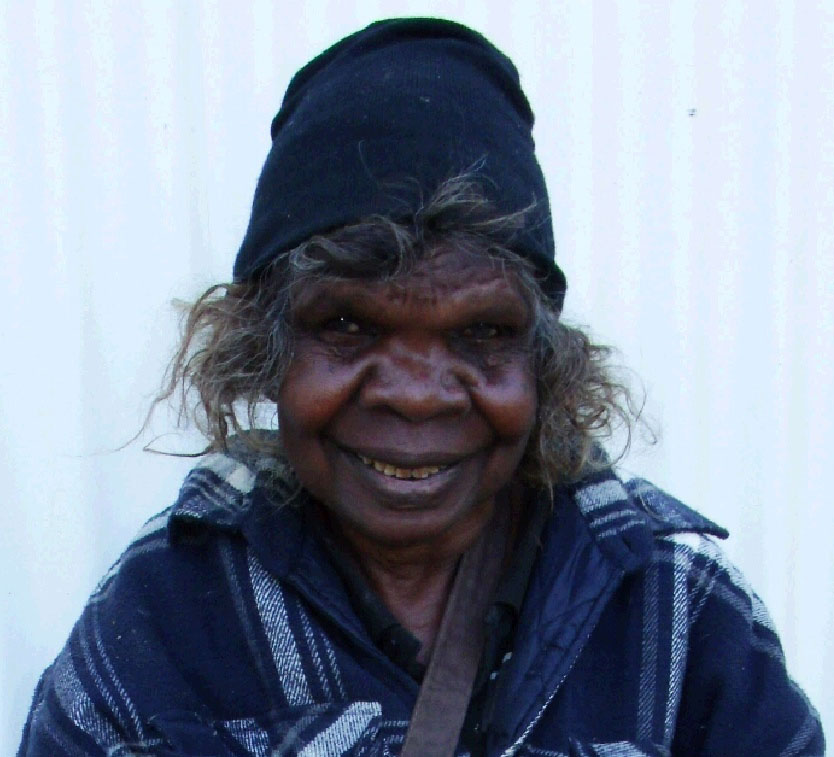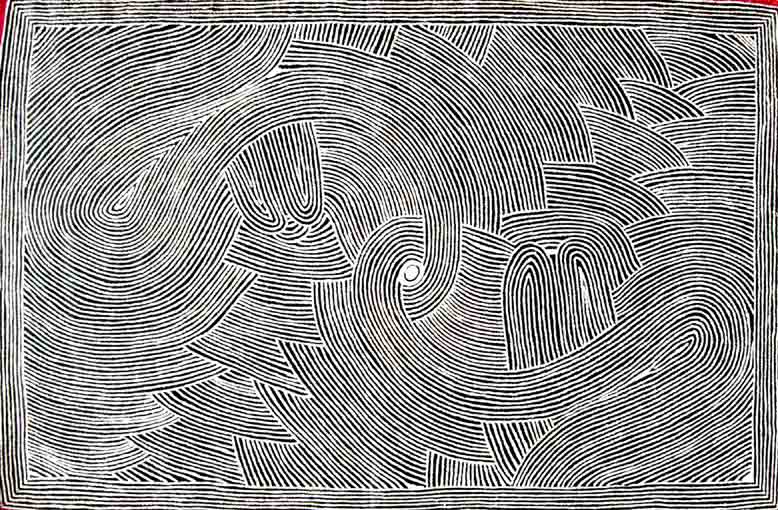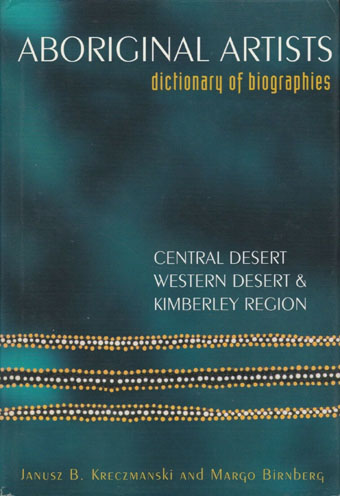|
 Biography
Narpula Napurrula Scobie
B.1950 Biography
Narpula Napurrula Scobie
B.1950
.png)
Narpula Scobie Napurrula was born around 1950 near Haasts Bluff and
grew up in Papunya in Central Australia.
Nabula Scobie Napurrula
also
known as Nabula Scobie
is a well-known Australian Aboriginal artist.
Biography
page 266,
Aboriginal Artists dictionary of biographies.
Narpula is the sister of the great painter
Turkey Tolson Tjupurrula
(1942-2001). Mother of Narpula Scobie is Nganyima Napaltjarri.
Aboriginals did practice polygamy and Narpula Scobie shared her father Tupa
Tjakamarra with Mitjili Napurrula (1945-2019)
from whom they inherited the right to paint works related to Ilyingaungau in the
Gibson Desert.
In the early 1980s years, Narpula began painting for
Papunya Tula Artists,
she was one of the first women to paint in her own right for
Papunya Tula.
Scobie created an explosion of creativity,
attaining further artistic recognition
painting exclusively acrylics on canvas.
Narpula is the widow of
Johnny Scobie Tjapanangka
(1938-2000) who was one of the original shareholders and artist with
Papunya Tula Artists.
In 1984 Scobie won the
Alice Prize.
In 2001 won the 1st Prize, the prestigious 18th the prestigious
Australian Aboriginal and Torres Strait Islander
NATSIAA
Art Award.
Vivien Johnson, a
curator
and a famous
writer on Indigenous
Australian art, describes
Nabula Scobie Napurrula as ‘a brilliant artist in her own right’.
Scobie Napurrula paintings have the sheer physical presence of the much
contemporary work of fine art, with
intensity and dynamic movement of
multi-dimensional
of space and depth.
Narpula Scobie
is
successful in the
World Art Market,
Scobie's
'Windbreak Rockhole and Women's Body
Paint'
canvas for sold $9,840 (Elder Fine Art).
Narpula Scobie Naparrula work is held in worldwide collections
ArtBank,
National
Gallery of Australia,
Art Gallery
of New South Wales,
Art Gallery
of South Australia,
National
Gallery of Victoria,
Art Gallery of Western Australia,
Museum & Art Gallery Northern Territory,
Queensland Art Gallery,
Powerhouse
Museum Sydney,
Australian Museum,
Richard
Kelton Foundation Santa Monica USA,
Homes a Court Collection
and Australian State Galleries.
Narpula Scobie Napurrula paints subjects associated with the Dreaming stories of
her brother Turkey Tolson Tjupurrula, as well as Dreaming of Women ceremonies
and ritual body painting motifs.
One of the Dreaming of Women’s stories relates to the Ancestral women who
travelled from the south at Mitukatjirra travelling to Ngutjul then on to
locations to the north-west.
Narpula paintings relate to women’s ceremony and of traditional bush foods
designs. Narpula depicts Dreaming (stories) of bush food, including the 'Two
Women who came from Mitukutjarrayi' in the south.
Narpula also depicts the travels of the Rainbow Snake during the time of
creation. According to Aboriginal ancient believes “Wanampi” (snake) travelled
underground and as it reached the surface it would create a waterhole, and each
of these locations became sacred sites for ceremonial purposes. The markings of
the snake became designs used for body decoration during tribal dance. Grid
patterns represent the landscape, “U” shapes represent the women as they collect
bush food sourced in areas shown as small concentric circles.
Narpula Scobie Napurrula lives at Mt Liebig with her children and grandchildren.
Narpula feels very strongly about her cultural beliefs and this clearly comes
through in her painting. She encourages younger generations to learn about their
culture and Dreamings, telling the ancient stories both in ceremonial sand
painting and with painting on canvas.
Scobie grew up with the traditions of desert art and worked at Papunya at an
historic moment in time. As around 1970 at Papunya the desert art movement began
and the movement of Aboriginal art gained momentum.
In 1971 Nabula was about twenty one years old,
she become the ‘promised’ bride
to
Johnny Scobie Tjapanangka
1938-2000 -
Johnny Scobie Tjapanangka | National
Museum of Australia
Nabula married Johnny Scobie Tjapanangka, a
well-known Pintupi artist who was involved at the beginning of the art movement
in Papunya in the 70's.
Johnny Scobie Tjapanangka
was one of the list of original shareholders of
Papunya Tula Artists, only a handful of paintings are attributed to him from the very early years.
Vivien Johnson
writes in her book about the couple, Scobie Napurrula and
Johnny Scobie Tjapanangka.
Vivien Johnson describes Napurrula as ‘a talented artist in her own
right’ Scobie was regarded as the ‘founder’ female painter at Kintore.
The couple lived first at Haasts Bluff where Johnny worked as a stockman at the
government cattle station, before moving to Papunya Narpula is tall and slender
like her brother, but
Johnny Scobie Tjapanangka was, in Dick
Kimber’s words, ‘the tallest Pintubi man at about 6’5” (1.9m)’.
After her husband
Johnny Scobie Tjapanangka
passed away, Narpula
moved back to their traditional lands around Kintore which West of
Alice Springs, some kilometers from the Western Australian border. Settling
there she continued to paint for
Papunya Tula Artists.
Narpula Scobie Napurrula lives at Mt Liebig with her children and grandchildren
and feels very strongly about her cultural beliefs and this clearly comes
through in her painting.
Narpula
Scobie encourages younger generations to learn about their
ancient culture Dreamings, she is sharing the Dreaming stories in ceremonial sand
painting and also in paintings on canvas.
Awards
1984
Alice Prize
Alice Springs Art Award, Alice Springs
2001
(1st Prize) the
prestigious
18th
the prestigious
Australian Aboriginal and Torres Strait Islander
NATSIAA
Art Award
Major Exhibitions:
1984 Papunya and Beyond, Araluen Art Centre, Alice Springs
1985 Two Worlds Collide: Cultural Convergences in Aboriginal and White
Australian Art, Artspace, Sydney
1987 Art and Aboriginality, Aspex Gallery, Portsmouth
1987 Art and Aboriginality, Portsmouth
1988 Queensland Museum, Brisbane, Australia
1988 Aboriginal Paintings incorporating the Maude Vizard-Wholohan Art Prize
Purchase Awards, Art Gallery of South Australia, Adelaide
1988 Art and Aboriginality, Portsmouth
1988
Wanderausstellung
Australian Art Exhibition touring China
1990 Friendly Country and Friendly People, Araluen Centre for the Arts, Alice
Springs, Australia
1991 The Painted Dream. Contemporary Aboriginal Paintings, Auckland City Art
Gallery, Auckland, New Zealand
1994 Chapman Gallery, Canberra, Australia
1995 Araluen Arts Centre, Alice Springs NT
1996 Papunya Tula Artists Pty. Ltd., Alice Springs
1997 Art Gallery of South Australia, Adelaide
1997 Geschichtenbilder, Aboriginal Art Galerie Bähr, Speyer
1998 Araluen Arts Centre, Alice Springs NT
1999 Flinders University of South Australia, Adelaide, Australia
2000 Araluen Arts Centre, Alice Springs NT
2003 Chapel on Chapel Gallery, Melbourne VIC
2005 Watiyawanu Artists, Japingka Gallery Fremantle WA
2006 Watiyawanu, Bond Aboriginal Art, Adelaide SA
2006 Australian Aboriginal Art 2006/2007, John Gordon Gallery, Sydney NSW
2007
Watiyawanu Artists of Amunturrngu, Japingka Gallery, Fremantle WA
2001
Museum and Art Gallery of the Northern Territory Australian National Aboriginal
and Torres Strait Islander Telstra Award
(1st Prize)
2001 Aboriginal Art 2001, Scott Livesey Art Dealer, Melbourne, Australia
2001 Galerie Knud Grothe, Charlottenlund, Denmark
2001 Museé des Beaux Arts et d´Archeologie de Vienne

COLLECTIONS:
ArtBank Sydney
Homes a Court Collection
National Gallery of Australia (Canberra)
Art Gallery of New South Wales (Sydney)
Art Gallery of South Australia (Adelaide)
National Gallery of Victoria (Melbourne)
Art
Gallery of Western Australia (Perth)
Museum & Art Gallery Northern Territory (Darwin)
Queensland
Art Gallery, Brisbane
Powerhouse Museum Sydney
Australian Museum, Sydney
Richard Kelton Foundation, Santa Monica, USA
Thomas Vroom Collection
Flinders
Art Museum, Adelaide
private collections USA, Miami, USA, China, Germany,
Denmark, Poland, Indonesia

Awelye
refers to women’s ceremonies associated with women’s business and refers to the
painting of designs on a woman’s body. Awelye makes connections with the
fertility of the land and a celebration of the food it provides. It is performed
by Aboriginal women from the Utopia region to recall their ancestors, to show
respect for their country and to demonstrate their responsibility for the
wellbeing of their community.
Awelye ceremonies begin with the women painting each other’s bodies in designs
relating to a particular woman’s Dreaming and in accordance with their skin
name. The Awelye designs represent a range of Dreaming’s including animals and
plants, healing and law.
In what has been described as a sensuous and meditative performance, the designs
are painted on the upper breast, chest and arms using powders ground from ochre,
charcoal and ash. It is applied in raw linear and curved lines, while the women
sing Dreaming songs of Ancestral figures and activities. The final part of the
ceremony is when the women assiduously perform dance cycles specific to site. In
many cases, the preparation for body paint and dances take much longer than the
performance.
Body art or Aboriginal body painting is a major part of aboriginal culture. The
designs or patterns reflect each person relationship and standing in Aboriginal
community and also their ancestors and totem animal. The painting is part of the
complex laws and religion and stories that make up ceremonial life. Each
ceremony has different painting symbols used as a link specifically for that
particular ceremony. Cultural ceremonies are performed once the initiation
ceremony is fulfilled by participants then they are able to fully fulfil their
obligations. The initiation ceremony takes many hours or days of preparations
and training sessions. A person cannot change their body art design and the
designs are not applied by the individual. This body art is also representative
of the various regions and their totemic responsibilities to that group showing
the participants position within this grouping. The initiated women and men are
carefully painted to perform this sacred ceremony.
|
Literature
Source
& FURTHER
REFERENCES
.png)

Nabula Scobie Napurrula
also
known as
Nabula Scobie
Biography
page 266 ,
Aboriginal
Artists dictionary of
biographies.
Australian Aboriginal Artist dictionary of biographies
Kreczmanski,
Janusz B and Birnberg, Margo (eds.): Aboriginal Artists: Dictionary of
Biographies: Central Desert, Western Desert and Kimberley Region JB
Publishing Australia, Marleston, 2004.
Aboriginal Artists of the Western Desert - A Biographical Dictionary by
Vivien Johnson, published by Craftsman House 1994
The Oxford Companion to Aboriginal Art and Culture edited by Sylvia
Kleinert and Margo Neale published by OUP 2000
Aboriginal
Artists: Dictionary of Biographies: Central Desert, Western Desert &
Kimberley Region JB Publishing Australia, Marleston, 2004
Brody, A.
1989 Utopia women’s Paintings: the First Works on Canvas, A summer
Project, 1988-89 exhib. Cat. Heytesbury Holdings, Perth Brody
A. 1990
Utopia, a picture Story, 88 Silk Batiks from the Robert Homes a Court
Gallery and gallery Collection, Heytesbury Holdings LTD Perth NATSIVAD
database, Latz, P. 1995, Bushfires & Bushtucker, IAD Press, Alice
Springs
Brody, A.
1989 Utopia women’s Paintings: the First Works on Canvas, A summer
Project 1988-89 exhib. Cat. Heytesbury Holdings, Perth Brody
Amadio, N. und
Kimber, R., Wildbird Dreaming. Aboriginal Art from the Central Deserts
of Australia, Greenhouse Publ., Melbourne 1988; Auckland City Art
Gallery, Auckland 1990, Ausst. Kat.; Australian Aboriginal Art from the
Collection of Donald Kahn. Lowe Art Museum, University of Miami (Hrsg.),
1991, Ausst. Kat.; Droombeelden - Tjukurrpa. Groninger Museum (Hrsg.),
Groningen 1995, Ausst. Kat.; Isaacs, J., Australia´s Living Heritage.
Arts of the Dreaming, Lansdowne Press, Sydney 1984; Isaacs, J.,
Australian Aboriginal Paintings. Lansdowne, Sydney 1989, ISBN
186302011X; Johnson, V., Aboriginal Artists of the Western Desert. A
Biographical Dictionary, Craftsman House, East Roseville 1994, ISBN
9768097817; Modern Art - Ancient Icon. The Aboriginal Gallery of
Dreamings (Hrsg.), o.O. 1992, ISBN 0646080520; Nangara. The Australian
Aboriginal Art Exhibition from the Ebes Collection. The Aboriginal
Gallery of Dreamings (Hrsg.), Melbourne 1996, Ausst. Kat.; Stourton, P.
Corbally, Songlines and Dreamings. Lund Humphries Publ., London 1996,
ISBN 0853316910; The Painted Dream. Contemporary Aboriginal Paintings.
Johnson, V. (Hrsg.), Auckland City Art Gallery, Auckland 1991, Ausst.
Kat.; Tjinytjilpa. The Dotted Design. Aboriginal Art Galleries of
Australia (Hrsg.), Melbourne 1998, Ausst. Kat.; Traumzeit - Tjukurrpa.
Kunst der Aborigines der Western Desert. Die Donald Kahn-Sammlung,
Danzker, J.B. (Hrsg.), Prestel, München und New York 1994, Ausst. Kat.;
Voices of the Earth. Paintings, Photography and Sculpture from
Aboriginal Australia. Gabrielle Pizzi (Hrsg.), Gallery Gabrielle Pizzi,
Melbourne 1996, Ausst. Kat., ISBN 0646288954. |
|